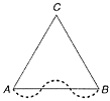| The Investigation poses questions to generate interest in various mathematical topics from the text and encourages students to formulate and investigate their own conjectures. One use of the investigations is for term papers in which students report on their conjectures and the patterns they find.
Click on the Read Me file below to open the investigation in a Word file:
 Read Me - Tessellations Instructions (Word Format)
(35.0K) Read Me - Tessellations Instructions (Word Format)
(35.0K)
Laboratory Investigation 11.2Tessellations
The following steps illustrate a method of altering the sides of an equilateral triangle to obtain a non polygonal figure that will tessellate. These steps can be carried out with pencil and paper or by computer software programs.
Step 1 Draw a curve from A to B.
 <a onClick="window.open('/olcweb/cgi/pluginpop.cgi?it=jpg::::/sites/dl/free/0072533072/78543/LI_11_2a.jpg','popWin', 'width=NaN,height=NaN,resizable,scrollbars');" href="#"><img valign="absmiddle" height="16" width="16" border="0" src="/olcweb/styles/shared/linkicons/image.gif"> (14.0K)</a> <a onClick="window.open('/olcweb/cgi/pluginpop.cgi?it=jpg::::/sites/dl/free/0072533072/78543/LI_11_2a.jpg','popWin', 'width=NaN,height=NaN,resizable,scrollbars');" href="#"><img valign="absmiddle" height="16" width="16" border="0" src="/olcweb/styles/shared/linkicons/image.gif"> (14.0K)</a> <a onClick="window.open('/olcweb/cgi/pluginpop.cgi?it=jpg::::/sites/dl/free/0072533072/78543/LI_11_2b.jpg','popWin', 'width=NaN,height=NaN,resizable,scrollbars');" href="#"><img valign="absmiddle" height="16" width="16" border="0" src="/olcweb/styles/shared/linkicons/image.gif"> (14.0K)</a> <a onClick="window.open('/olcweb/cgi/pluginpop.cgi?it=jpg::::/sites/dl/free/0072533072/78543/LI_11_2b.jpg','popWin', 'width=NaN,height=NaN,resizable,scrollbars');" href="#"><img valign="absmiddle" height="16" width="16" border="0" src="/olcweb/styles/shared/linkicons/image.gif"> (14.0K)</a> <a onClick="window.open('/olcweb/cgi/pluginpop.cgi?it=jpg::::/sites/dl/free/0072533072/78543/LI_11_2c.jpg','popWin', 'width=NaN,height=NaN,resizable,scrollbars');" href="#"><img valign="absmiddle" height="16" width="16" border="0" src="/olcweb/styles/shared/linkicons/image.gif"> (16.0K)</a> <a onClick="window.open('/olcweb/cgi/pluginpop.cgi?it=jpg::::/sites/dl/free/0072533072/78543/LI_11_2c.jpg','popWin', 'width=NaN,height=NaN,resizable,scrollbars');" href="#"><img valign="absmiddle" height="16" width="16" border="0" src="/olcweb/styles/shared/linkicons/image.gif"> (16.0K)</a>- If the preceding figure is used to form a tessellation, which of the transformations (rotation, translation, reflection) will map the preceding tessellation onto itself?
- Step 3 produces a curve on one side of the triangle that is said to have point symmetry because it can be rotated onto itself by a 180˚ rotation. Suppose Step 3 is used to produce a curve with point symmetry on all three sides of a triangle. Will the resulting figure tessellate?
- Suppose Step 3 is used to create a curve with point symmetry on each of the six sides of a regular hexagon. Will the resulting figure tessellate?
|



